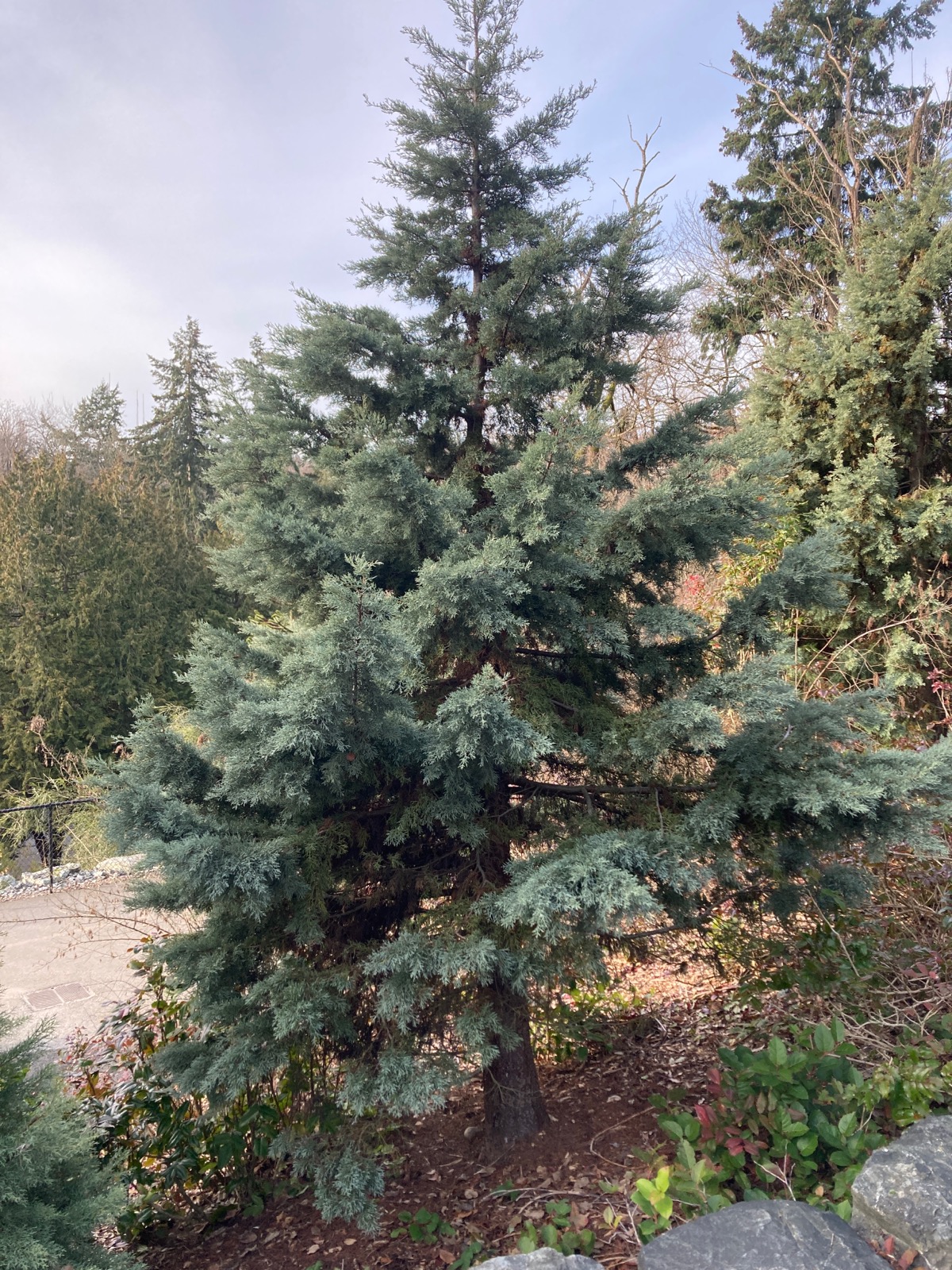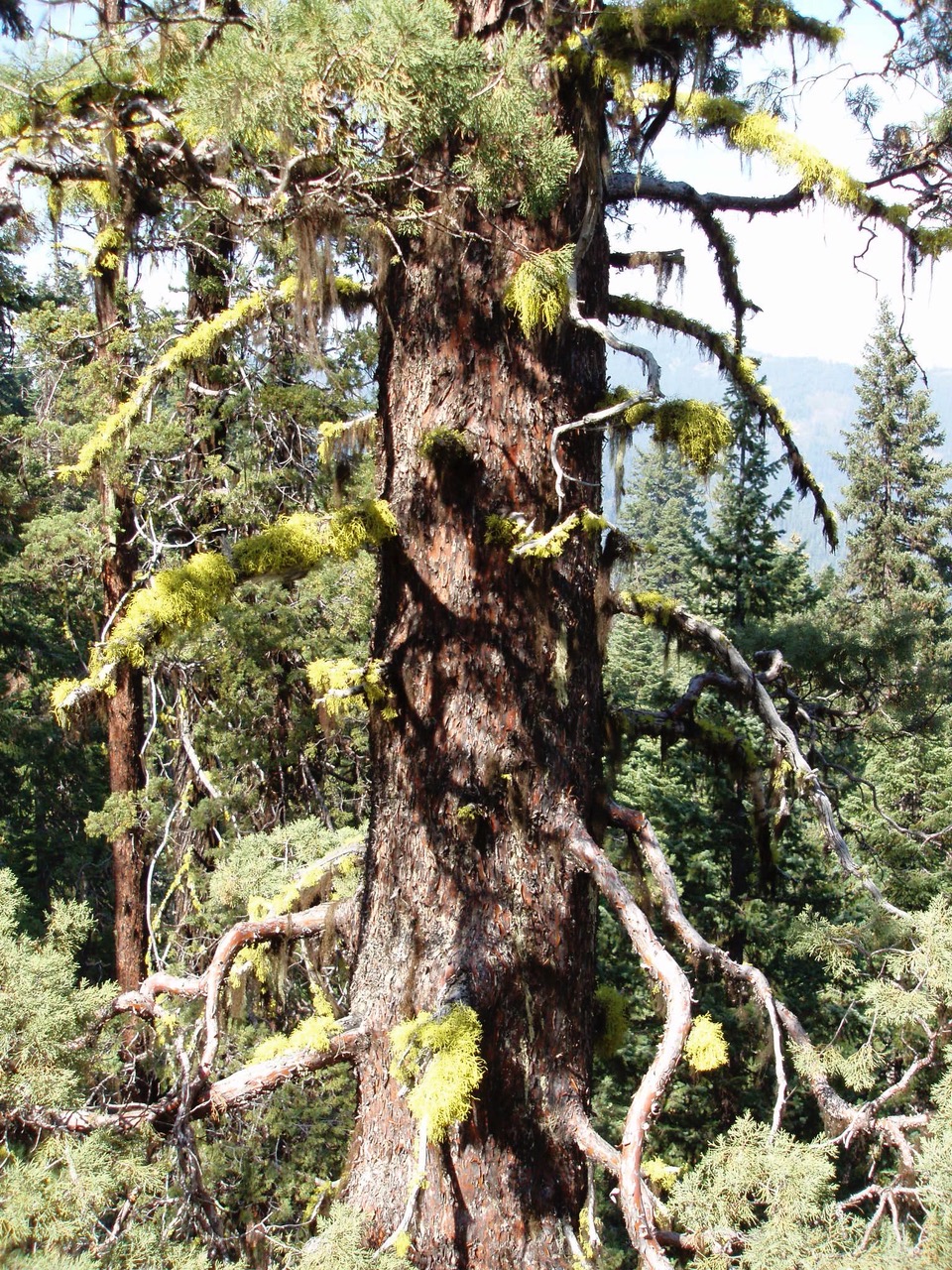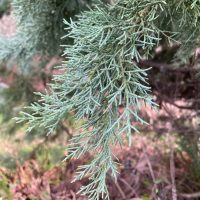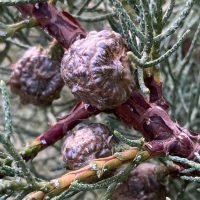February 2023 Plant Profile: Baker Cypress
Scientific name: Cupressus bakeri
Synonyms: Hesperocyparis bakeri, Callitropsis bakeri, Neocupressus bakeri, Cupressus macnabiana var. bakeri
Common name: Modoc cypress, Baker cypress, Siskiyou cypress
Family: Cupressaceae
Native Range: Southern Oregon to Northern California, in disjunct populations. 3,500-7,500 ft.
Height and Spread: Typical height and width- 85’ by 35’. Largest known specimen is 137’ tall with a spread of 27’ wide.
Conservation status: Vulnerable
In the Arboretum: 736-42-C along the east fence (33-7E). 253-08 A,B,C,D (1-4E, 1-5E) and 253-08 E, F, G, H, I and J (0-4E) all in the Cascadia Forest section of the Pacific Connections Garden.

The Baker cypress, the most northern and hardiest cypress in North America is a tree with a challenging future ahead of it. Within its native range of southern Oregon and northern California there are several populations, many a long distance separate from others. Often populations occupy a high ridge, growing in open, sunny, mixed-evergreen forests between the elevations of 3500 feet and 7500 feet.
The has been much taxonomic confusion over the years as to how to classify Cupressus bakeri in terms of both genus and subspecies names. The Arboretum used to separate out Cupressus bakeri into two subspecies, C. bakeri ssp. bakeri and C. bakeri ssp. matthewsii as they were received as such. The latter grows in the Siskiyou mountains of southern Oregon and is known as the Siskiyou cypress. (The other subspecies, C. bakeri ssp. bakeri, is known as the Modoc cypress, in reference to the Modoc plateau, a dry volcanic region which is located along the eastern portion of the California-Oregon border and contains many of the populations of Baker cypress.) The subspecies had been separated out from the main species due to differences in size of the female cones, however not all researchers agree that this is warranted. It is now generally thought that the morphological differences are due simply to the serpentine soils that are present in the Siskiyou forest.
Serpentine soils are typified by low calcium to magnesium ratios, low content in many other plant nutrients as well as high concentrations of heavy metals which are often toxic to plant life. When some individual plants are removed from a serpentine soil environment and grown on typical local soils, they lose their Serpentine-specific morphological traits and are indistinguishable from any other plants of their species. However, some plant species develop phenotypic differences in their DNA which translates into advantages to living in a serpentine environment. If such a plant is transplanted to another environment, it may be unable to adjust and grow poorly.

Almost exclusively the populations of Cupressus bakeri grow on either serpentine or volcanic soils in the wild. What these soils have in common is a low nutrient, shallow profile typical of soil which supports only sparse vegetation. Indeed C. bakeri is almost entirely intolerant of shade and will defoliate if it is faced will any close competition. Similarly, seeds of C. bakeri will not germinate in the shade. In fact, it has been shown that seeds of C. bakeri will refuse to grow on soils that have developed under the canopies of other tree species , singularly preferring the spare and rocky soil to any brown duff that might have developed under Abies magnifica, one of its plant community partners. It has been shown that seedlings of C. bakeri are extremely sensitive to damping off diseases, which are less prevalent on bare mineral soils.
In addition to the inherent sensitive nature of young Baker cypress trees, human-kind is assisting in making the survival of the species a challenge. Baker cypress is not only a fire adapted species, but fire dependent species as well. The 1.5 inch, globular female cones of C. bakeri contain up to 100 seeds per cone and are produced abundantly upon trees 14 years or older. However, these cones only open with the heat of a forest fire, or to a much lesser degree as they desiccate with old age. The heat of the fire melts and boils the resin within the cone, releasing the seed, which are distributed out over the following three months onto the recently burned and sterile soil. The parent trees, having a beautiful dark brownish-red peeling bark which is exceedingly thin, are easily killed by fire. The sacrifice of the older generation aids the younger generation by reducing the amount of shade present for the new seedlings.
- Scale leaves
- Female Cone
- Male Cones
Fire suppression by humans has had a serious negative effect on the populations of the Baker cypress. Without fire, seeds are only dispersed minimally as cones slowly desiccate and the seeds fall on soil occupied by other vegetation, resulting in the shading out and damping off of a high percentage of seedlings. In addition, fire suppression allows Abies concolor and Abies magnifica to expand their territory into these previously fire dominated conditions, transforming the bare soil to duff and the hot open sky to a shading canopy. Efforts are now underway to help the Baker cypress by doing controlled burns and removing competing trees manually. The movement to reduce fire suppression in the face of climate change and the many destructive wildfires occurring, understandably has been a cultural and political struggle.
As if an ecological existential crisis wasn’t enough for this species, the Baker cypress has endured a taxonomic crisis of identity practically from its introduction into western horticulture. The Baker cypress was first encountered by the western botanist Milo Samuel Baker in 1898 at what is now known as Timbered Crater, north of Mt Lassen in northern California. In 1909 Willis Linn Jepson, a botanist associated with the University of California at Berkeley, officially first described the species and so named it in honor of Milo Baker Cupressus bakeri. However, in 1923 Jepson himself reclassified the species as a variety of Macnab cypress, Cupressus macnabiana var. bakeri. 25 years later, in 1948 the botanist Carl Brandt Wolf of Harvard university returned the Baker cypress back into its original classification where it stayed for 58 years. Then, in 2006 botanist Damon P. Little of Cornell university moved the Baker cypress into the genus Callitropsis using “Data from anatomy, biochemistry, micromorphology, reproductive development, reproductive morphology, and vegetative morphology … combined with molecular sequence data” to quote his 2006 paper for the American Society of Plant Taxonomists.

Just three years later in 2009, the botanist David John de Laubenfels of Syracuse university, seemingly casually dismissed Little’s mass of information as a “suite of characters, no one alone being diagnostic” and created an entirely new genus, Neocupressus, in which was placed the Baker cypress, now Neocupressus bakeri. De Laubenfels decision was based on two concrete observations: 1. New world cypress (think Cupressus) have multiple cotyledons (the first “leaves” to appear in a germinating seed) as opposed to old world cypress (think Juniperus) which have only two. And 2. New world cypress have monomorphic (one-shape) leaves as opposed to dimorphic (two-shapes) or polymorphic (many-shapes).
Unfortunately for de Laubenfels, also in 2009 Jim Bartel of the US Fish and Wildlife published a paper in which he states “Phylogenetic comparisons of three nuclear DNA gene regions… and a chloroplast region show that the Western Hemisphere cypresses is a well-supported clade quite separated from the Eastern Hemisphere cypresses. Based on these new data and previous data, a new genus, Hesperocyparis, is erected for the Western Hemisphere species previously placed in the genus Cupressus”. Typically DNA evidence of relationships trumps any morphological observations, but as of yet the name is still unresolved, with most sources maintaining Cupressus bakeri as an accepted, if not preferred, name. This is how the Arboretum labels our trees, and the subspecies are no longer recognized.

The bark of a mature Baker cypress is its most attractive feature. The red-brown bark is thin and peels slowly as it grows revealing layers with multiple colorations. The fragrant, scale leaves are grey-green, somewhat glaucus, typically covered in resin blisters and are arranged alternately in a square cross as they progress down the stem (decussate). The female cones take two years to develop seeds and appear as leathery, slightly knobby balls. These cones persist for years waiting for the heat of a fire to open and shed their seed. The crown is narrow and conical, with sparse branching.
Wild populations of Baker cypress exist on well-drained soils as their seedlings are susceptible to excessive moisture and damping off diseases. Cultivated trees should also be planted in well drained soils but will be more tolerant to the garden soil habitat than their wild population suggests. Watering will not be necessary once established. Baker cypress remain shade intolerant throughout their life span and will shed any leaves that are shaded by neighbors. Cold tolerance estimates range from USDA zone 5 to zone 7.
In the Washington Park Arboretum many young Baker cypress can be viewed on the sunny slope at the south end of the Cascadia garden of Pacific Connections. These are very attractive and have been growing steadily and fully since they were grown from seed collected by Arboretum staff in the wild in 2008. A specimen of “Siskiyou” subspecies of baker cypress accessioned in 1942 is growing along the east fence of the Arboretum, behind the compost bins. It has suffered from lack of needed full sun conditions over the years, though newer growth at the top is fuller with more sun available.
Sources:
Adams, Robert & Bartel, Jim & Price, Robert. (2009). A new genus, Hesperocyparis, for the cypresses of the western hemisphere (CUPRESSACEAE). Phytologia
de Laubenfels, D. J., Nomenclatural Actions for the New World Cypresses (Cupressaceae), Novon: A Journal for Botanical Nomenclature, 19(3) : 300-306, Missouri Botanical Garden Press
EVOLUTIONARY ECOLOGY OF PLANT ADAPTATION TO SERPENTINE SOILS- Kristy U. Brady, Arthur R. Kruckeberg, and H.D. Bradshaw Jr. Department of Biology, University of Washington
Little, D.P. 2006. Evolution and circumscription of the true cypresses (Cupressaceae: Cupressus). Systematic Botany 31 (3): 461–480.
The University and Jepson Herbaria, UC Berkeley, ucjeps.berkeley.edu https://resolver.globalnames.org
Oregon State University, https://landscapeplants.oregonstate.edu/
The Gymnosperm Database, https://www.conifers.org
International Dendrology Society, https://treesandshrubsonline.org
Fire Effects Information System, US Forest Service, https://www.fs.usda.gov/
New York Botanic Garden, https://www.nybg.org
California Native Plant Society, https://calscape.org
Integrated Taxonomic Information System (ITIS), https://www.itis.gov
U.S. National Plant Germplasm System, USDA, https://npgsweb.ars-grin.gov/gringlobal/taxon/taxonomydetail?id=415355


